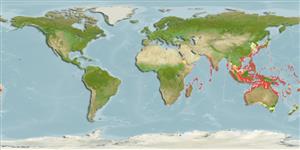Environment: milieu / climate zone / depth range / distribution range
Οικολογία
Θαλασσινό(ά) Υφαλόφιλο(α); εύρος βάθους 1 - 55 m (Ref. 9710). Subtropical
Indo-West Pacific: tropical and subtropical waters, South Africa eastward through Indonesia; northward to southern Japan; southward to the east coast of Australia (Ref. 33352). Southeast Atlantic: south coast of South Africa.
Μέγεθος / Βάρος / Age
Maturity: Lm ? range ? - ? cm
Max length : 19.0 cm TL αρσενικό/απροσδιόριστο; (Ref. 9710)
Ραχιαίες άκανθες (συνολικά): 2; Μαλακές ραχιαίες ακτίνες (συνολικά): 43-50; Εδρικές άκανθες 0; Μαλακές εδρικές ακτίνες: 41 - 46. Pale brown to grey in color; two brown stripes on body; adults with yellow spots on head and body; soft dorsal and anal fins yellowish; caudal fin dark brown (Ref. 4421).
Inhabit coastal reefs and enter estuaries. Often in silty habitat and usually on slopes with low rubble reef and rich invertebrate growth, ranging to moderate depths (Ref. 48637). Found on weedy and sandy areas of lagoon and seaward reefs (Ref. 9710). Often found in pairs (Ref. 9710). Sometimes solitary or in groups (Ref. 90102). Juveniles hide or shelter near seawhips or seapens (Ref. 48637).
Life cycle and mating behavior
Γεννητική Ωρίμανση | Αναπαραγωγή | Γεννοβολία | Αβγά | Γονιμότητα | Προνύμφες
Masuda, H., K. Amaoka, C. Araga, T. Uyeno and T. Yoshino, 1984. The fishes of the Japanese Archipelago. Vol. 1. Tokai University Press, Tokyo, Japan. 437 p. (text). (Ref. 559)
IUCN Red List Status (Ref. 130435)
Threat to humans
Harmless
Human uses
Περισσότερες πληροφορίες
Κοινά ονόματαΣυνώνυμαΜεταβολισμόςΘηρευτέςΟικοτοξικολογίαΑναπαραγωγήΓεννητική ΩρίμανσηΓεννοβολίαΣυναθροίσεις γεννοβολίαςΓονιμότηταΑβγάEgg development
ΑναφορέςΥδατοκαλλιέργειεςΠροφίλ υδατοκαλλιέργειαςΣτελέχοιΓενετικήElectrophoresesΚληρονομικότηταΑσθένειεςΜεταποίησηNutrientsMass conversion
ΣυνεργάτεςΦωτογραφίεςStamps, Coins Misc.ΉχοιΣιγκουατέραΤαχύτηταΚολυμβητικός ΤύποςΕπιφάνεια βραγχίωνOtolithsΕγκέφαλοιΌραση
Εργαλεία
Special reports
Download XML
Διαδικτυακές πηγές
Estimates based on models
Preferred temperature (Ref.
123201): 22.4 - 29, mean 27.7 °C (based on 974 cells).
Phylogenetic diversity index (Ref.
82804): PD
50 = 1.0000 [Uniqueness, from 0.5 = low to 2.0 = high].
Bayesian length-weight: a=0.00977 (0.00517 - 0.01847), b=3.07 (2.90 - 3.24), in cm total length, based on LWR estimates for this species & (Sub)family-body (Ref.
93245).
Τροφικό Επίπεδο (Ref.
69278): 3.1 ±0.0 se; based on diet studies.
Ελαστικότητα (Ref.
120179): Υψηλό, ελάχιστος χρόνος για διπλασιασμό πληθυσμού < 15 μήνες (Preliminary K or Fecundity.).
Fishing Vulnerability (Ref.
59153): Low vulnerability (10 of 100).
Nutrients (Ref.
124155): Calcium = 38.9 [14.5, 124.6] mg/100g; Iron = 0.757 [0.328, 1.742] mg/100g; Protein = 19.2 [17.0, 21.4] %; Omega3 = 0.227 [0.099, 0.466] g/100g; Selenium = 13.9 [6.2, 32.8] μg/100g; VitaminA = 62.3 [20.9, 191.6] μg/100g; Zinc = 1.04 [0.65, 1.73] mg/100g (wet weight);
